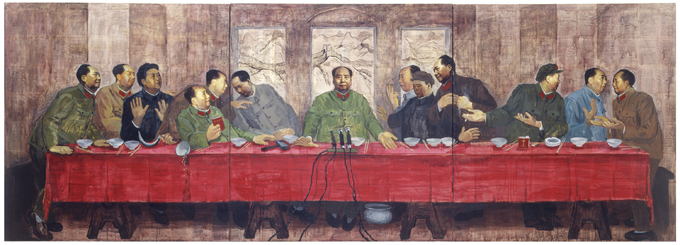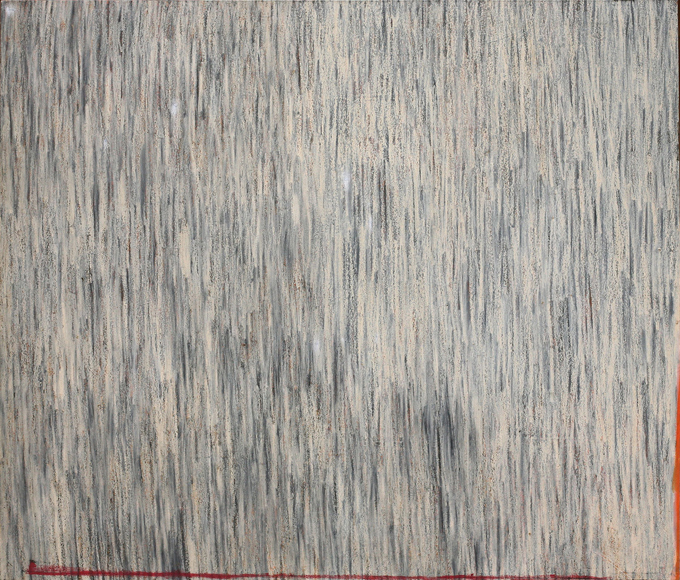
Zhang Hongtu, The Last Banquet, 1989.
On June 4, 1989, the Chinese military forcibly removed thousands of students demonstrating for democratic rights in Beijing’s Tiananmen Square. The student protesters, who had occupied the public square for seven weeks, elicited widespread sympathy among international audiences. Images of soldiers firing upon students and tanks running them over were broadcast on repeat around the world.
The Asian American Arts Centre, an alternative space in Manhattan’s Chinatown, responded to the June 1989 events with an open-call exhibition of artworks related to the uprising and its suppression. “China: June 4, 1989” included both figurative and abstract works; its centerpiece was a series of individually-painted doors linked to form a maze. The exhibition traveled around the country and became one of the most significant shows mounted by the Centre.
To commemorate the 25th anniversary of the Tiananmen crackdown, Creative Time Reports partnered with The Margins to interview three of the artists involved in that exhibition, as well as its organizer, Bob Lee. Below are the lightly edited responses from the artists Zhang Hongtu and Zhao Gang. To read the responses from artist Mel Chin and Asian American Arts Centre executive director Bob Lee, visit The Margins.
Every Action Helps Us to Remember
Zhang Hongtu
When I was a student in the 1950s, we trusted Mao. We believed that if we followed his ideas, not only would we change China, but we would also achieve world peace and end American imperialism. But after Mao’s actions against the Chinese people in the Cultural Revolution, and my experience of being exiled from the city and sent down to the countryside to work with farmers (along with millions of other teenagers), my trust soured into doubt and critique.
In 1982 I left China for New York to make art. Chinese art was still dominated by socialist realism, the style approved by the Ministry of Culture. I have always strived to make art that not only is pleasing to the eye but also shows my ideas about society. So in those early years I forgot everything that happened in China. I didn’t care about my nationality, identity, style or tradition. I just wanted to learn and do something new.
Then, in May 1989, I saw that people had started demonstrating and going on hunger strikes in Tiananmen Square. As the protests continued, I discovered that I was still very much Chinese. I was glued to the TV screen and recorded the news when I went to sleep. I didn’t want to miss anything, because if I were in China I would have been on strike too. For those few days, I think the people at Tiananmen felt free. A protest like that had never happened before in China’s history, and I have no idea if it will happen in the future.
After the Tiananmen crackdown, my art became more political, which led me to paint The Last Banquet and the door for the exhibition “China: June 4, 1989.” My friend told me that in China I would have been killed many times over for The Last Banquet. This only encouraged me further because in the United States I had the freedom to make this kind of art. I started cutting out iconic images of Mao from burlap, canvas, plywood and other materials. I still remember how carving out his likeness felt like a sin the first time. In China this act would be seen as “antirevolutionary” and severely punished—you simply can’t criticize Mao. But I kept cutting his image out of different materials as a form of therapy, until one day I stopped feeling bad about it.
People criticized me for not making “pure art” and said my art was a tool for politics, but I didn’t care, because these politics were my honest and true feelings. Every June 4, I think about 1989 and activist organizations like the Tiananmen Mothers—the parents and relatives of the youth killed that day who advocate for the government to admit its responsibility for the deaths. Meanwhile the party has continued to suppress any critiques about Tiananmen, the Cultural Revolution or Chairman Mao. My own website was even blocked in China for a few years. (It’s up now, but who knows how long that will last?)
Since the Chinese government prohibits all dissent, we must carry on here in the United States. In recent years I have posted images about the Tiananmen crackdown on Facebook each June 4 to remind people of what happened. Every action helps us to remember the students who were killed as well as their mothers, who are still struggling against a government that censors the anniversary of their children’s deaths.

Zhao Gang, After the Mass Killing, 1989. After the suppression of the 1989 student movement in China, Zhao Gang completed this painting in which, as an attempt to deny his past, he smeared and covered a number of his old pictures with oil pastels.
Everybody Wants to Be Bourgeois
Zhao Gang
I became involved in the exhibition “China: June 4, 1989” as an immediate reaction to the events in Tiananmen Square. You did what you could to support the students’ strike; it was almost a reflex. I also joined other Chinese artists living in New York, including Zhang Wei and Ai Weiwei, for a weeklong hunger strike in front of the United Nations. After the Tiananmen crackdown, I felt so ashamed that China’s government would commit such a backward, nasty, totalitarian act. It was an embarrassment for many Chinese people living or studying overseas, especially those in the United States.
At the time, I was preparing a show in New York’s SoHo neighborhood, but the massacre sapped my energy to go forward with the exhibition. I was confused for a long time and fell into a depression. I was in my late twenties, was living in New York and hadn’t expected to immigrate to the United States. I had thought I would go to graduate school and then return to China. Suddenly I felt hopeless about my own future because I wanted to go home but realized that I couldn’t.
I finally moved back to Beijing in 2007, and like many foreigners who first come to the city, I was hopeful and actively looking for opportunities. But the government is so corrupt. It’s disgusting how much money officials have embezzled from the people. After years of living in this totalitarian state, I feel that my fighting spirit has been challenged. Yet people are busy struggling to make a living, and nobody has time for so-called negative energy. Everybody wants to be positive.
Here, 25 years after the crackdown, only a very small group of people still talk about Tiananmen Square. Most locals don’t ever want to hear about it again because the mentality in China is that we are a peaceful society. I was just at dinner with some artists in Beijing, and sometimes in social situations like this one, I say something a bit outrageous. When people fall quiet, I realize that everybody wants to be bourgeois and maintain an even-keeled situation. These days, political awareness among the public remains very low. People benefit from complacency; they prosper from the status quo. As long as people can afford an apartment and drive better cars, they don’t care anymore.
A few years ago there were massive protests in Beijing that briefly created chaos and then quickly got dispersed. It was called the Jasmine Revolution, after what happened in Tunisia. The demonstrators went to Wangfujing, a major commercial street, and were immediately arrested. I’m pretty sure there are still people trying to stir up a movement like that one somewhere, but it’s hard to say if this cycle can be broken. The Communist Party is certainly facing major problems internally. That’s why President Xi Jinping initiated the anticorruption campaign—to try to comfort and provide hope to the people—but he is really opening up a can of worms. In the past China often looked beyond its borders for ideas, like finding communism in Europe, but now we will have to look within and do some soul-searching.
To read reflections on the June 4, 1989 events and exhibition from the artist Mel Chin and Asian American Arts Centre executive director Bob Lee, visit The Margins. A memorial version of “China: June 4, 1989,” including works from the original show, is currently on view at Whitebox Art Center (also located in Chinatown) through June 10.

